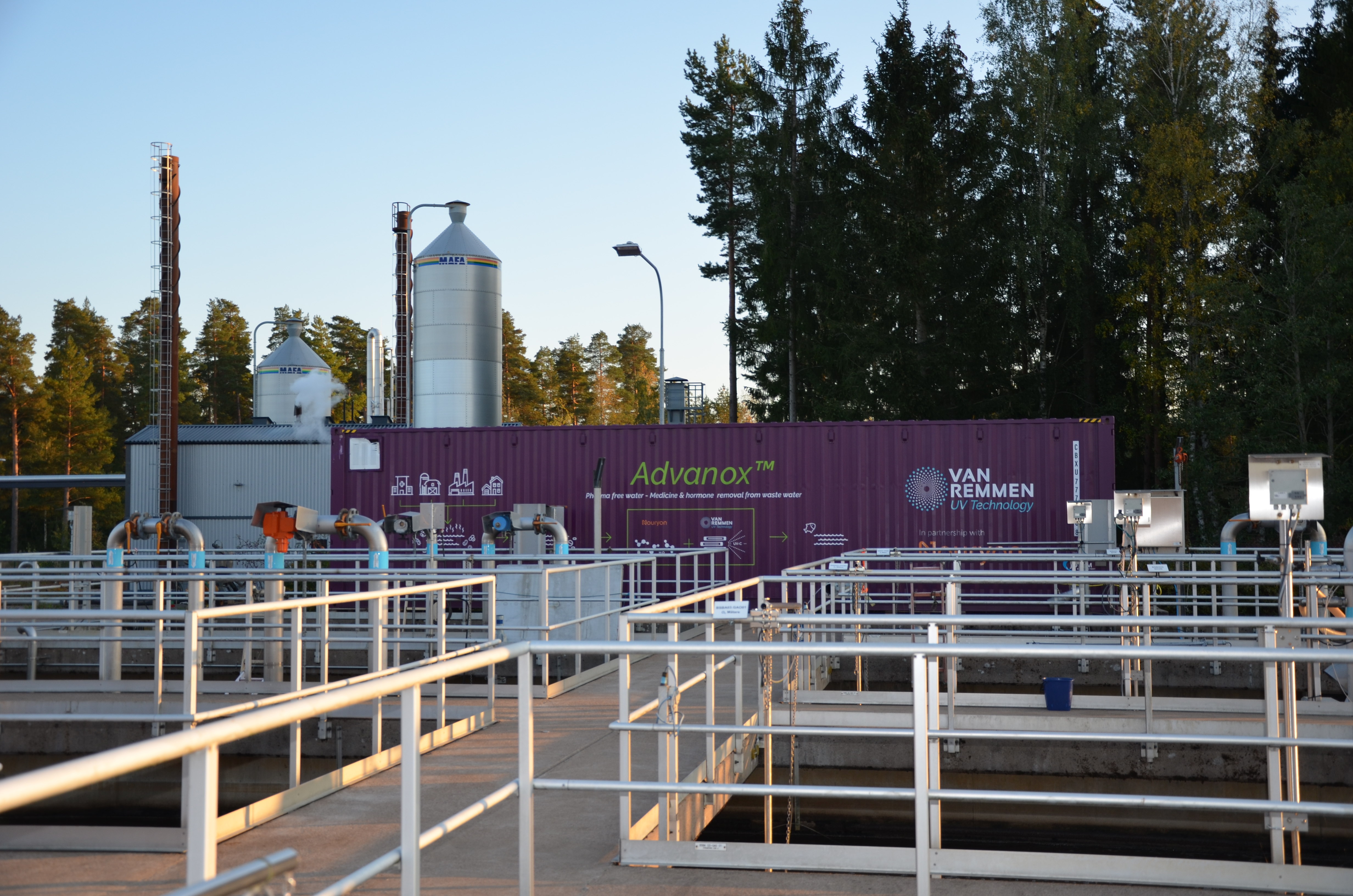At the wastewater treatment plant in Växjö municipality, Sweden, Van Remmen UV Technology has in partnership with Nouryon undertaken a national research project with our Advanox™ pilot for the removal of pharmaceuticals from wastewater.
Motivation
Micropollutants such as pharmaceuticals in surface water is a growing concern all over the world. Antibiotic resistance in bacteria, and both physical and behavioural changes in aquatic life are just some examples of why. Pharmaceuticals are designed to not be broken down by the body, meaning the rests end up in the wastewater treatment plants which in turn cannot remove a lot these often complex and persistent molecules.
The call for reliable treatment methods is becoming more insistent, and one of the techniques answering is the advanced oxidation process UV light combined with hydrogen peroxide (UV/HP). The Advanox™ pilot is built on this technique.
The Advanox™ pilot
The pilot consists of an Advanox™ reactor, hydrogen peroxide dosing and mixing, catalytic filter beds, cleaning in place functions, power supply, PLC, and a dose of clever engineering. All put together with the help of Jotem Waterbehandeling.
From Van Remmen UV Technology our newly developed Advanox™ reactor is specially designed for advanced oxidation with UV/HP in wastewater. Extensive modelling and 48 UV-lamps ensures optimal treatment with a high throughput compared to other types of reactors. The prototype currently used in the pilot can handle flows at up to about 150 m3/h in wastewater conditions.
Nouryon are our partners and hydrogen peroxide suppliers for all Advanox projects. They performed the initial laboratory scale tests in cooperation with IVL Swedish Environmental Research Institute (IVL Svenska Mijlöinstitutet) on a cocktail of pharmaceuticals which showed a >70% conversion already at relatively low UV and hydrogen peroxide doses.
The host for the Advanox™ pilot was the wastewater treatment plant Sundet in Växjö, Sweden. They perform sample collection and laboratory analysis of the water which will serve as the basis for the reporting.
The pilot research
The Advanox™ pilot arrived from the Netherlands in Växjö in the very end of July 2019 and the research officially started Tuesday 6th of August 2019 for a month long trial. It was kicked off with a series of shorter tests at different UV and hydrogen peroxide doses, before being set up for the longer trials which ran until the 5th of September 2019.
The results will be compiled into a report which will make their way to both IVL Swedish Environmental Research Institute and the Swedish Environmental Protection Agency (Naturvårdsverket) where it will be compared to other technologies for advanced water treatment and pharmaceutical removal.
First results
As of now, all results are not in yet, but the first results came in the middle of September and the results painted a very positive picture.
Already at the low setting of 5000 J/m2 UV light and 20 ppm of hydrogen peroxide the removal efficiency was 70% and the energy consumption was only 0,29 kWh/m3. Using higher UV and hydrogen peroxide doses, the removal efficiencies came up to 95%.
The technique
Inside the Advanox™ reactor the UV light splits the hydrogen peroxide molecules (H2O2) into highly reactive hydroxyl radicals (OH*) which in turn break down the pharmaceuticals. After the radicals are formed the breakdown of pharmaceuticals happens in the matter of milliseconds.
Hydrogen peroxide has many advantages compared to e.g. ozone with inherent higher safety, greater stability, and no toxic or carcinogenic by products. To further ensure the water quality any rests of hydrogen peroxide are removed after the pharmaceutical removal by passing the water through a catalytic filter bed. The hydrogen peroxide is then split up into water and oxygen leaving only clean water to enter the environment.
The Advanox™ technique fill several important functions. In UV/HP the advanced oxidation itself breaks down pharmaceuticals to much simpler molecules which lowers the strain on the ecosystem. Additionally, the relatively high UV dose easily disinfects the water to very safe levels. This is why UV/HP is one of the best ways of battling e.g. antibiotic resistance; consisting of both already resistant bacteria, and antibiotic rests in the water that disrupts the ecosystems by both kill off good bacteria and making way for more resistant ones. With UV/HP the advanced oxidation takes care of the antibiotic rests, and the UV dose takes care of the bacteria. The Advanox™ reactor is specially designed to be optimal for UV/HP, ensuring only the cleanest water possible is discharged into our lakes and rivers.




